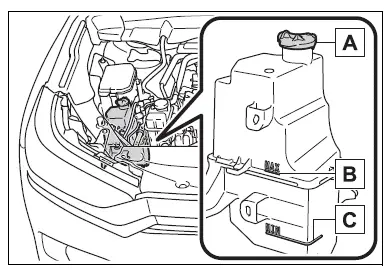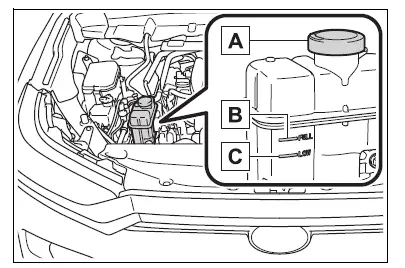Toyota Grand Highlander (AS10) 2024 Owners Manual / Maintenance and care / Engine compartment / Checking the coolant
Toyota Grand Highlander (AS10): Checking the coolant
■ Engine coolant reservoir
The coolant level is satisfactory if it is between the "MAX" and "MIN" lines on the reservoir when the engine is cold.

- Reservoir cap
- "MAX" line
- "MIN" line
■ Intercooler coolant reservoir
The coolant level is satisfactory if it is between the "FULL" and "LOW" lines on the reservoir when the engine is cold.

- Reservoir cap
- "FULL" line
- "LOW" line
If the level is on or below the "LOW" line, add coolant up to the "FULL" line.
■Coolant selection
Only use "Toyota Super Long Life Coolant" or a similar high quality ethylene glycol based non-silicate, non-amine, non-nitrite, and non-borate coolant with long-life hybrid organic acid technology.
U.S.A.:
"Toyota Super Long Life Coolant" is a mixture of 50% coolant and 50% deionized water. (Minimum temperature: -31ºF [-35ºC] )
Canada:
"Toyota Super Long Life Coolant" is a mixture of 55% coolant and 45% deionized water. (Minimum temperature: -44ºF [-42ºC] ) For more details about coolant, contact your Toyota dealer.
■If the coolant level drops within a short time of replenishing
Visually check the radiator, hoses, engine coolant reservoir caps, drain cock and water pump.
If you cannot find a leak, have your Toyota dealer test the cap and check for leaks in the cooling system.
WARNING
■When the engine is hot
Do not remove the engine coolant reservoir cap, intercooler coolant reservoir cap and radiator cap.
The cooling system may be under pressure and may spray hot coolant if the cap is removed, causing serious injuries, such as burns.
NOTICE
■When adding coolant
Coolant is neither plain water nor straight antifreeze. The correct mixture of water and antifreeze must be used to provide proper lubrication, corrosion protection and cooling. Be sure to read the antifreeze or coolant label.
■If you spill coolant
Be sure to wash it off with water to prevent it from damaging parts or paint.
Checking the radiator, condenser and intercooler radiator
Check the radiator, condenser and intercooler radiator and clear away any foreign objects.
If any of the above parts are extremely dirty or you are not sure of their condition, have your vehicle inspected by your Toyota dealer.
WARNING
■When the engine is hot
Do not touch the radiator, condenser or intercooler radiator as they may be hot and cause serious injuries, such as burns.
Similar pages:
AHB (Automatic High Beam)
The Automatic High Beam
uses a front camera located
on the upper portion of the
windshield to detect the
brightness of the lights of
vehicles ahead, streetlights,
etc., and automatically
changes the head
lights between the high
beams and low beams.
WARNING
■For safe use
Do not overly rely on the A ...
Adding engine oil
■ Checking the oil type and
preparing the item needed
Make sure to check the oil type
and prepare the items needed
before adding oil.
Engine oil selection
Oil quantity (Low level mark
→ Refill upper limit mark)
1.6 qt. (1.5 L, 1.3 Imp. qt.)
Item
Clean funnel
■ Adding engine oil
If the ...


